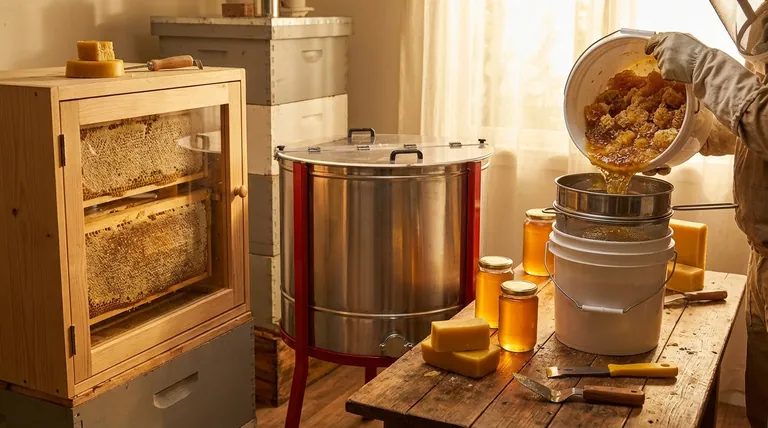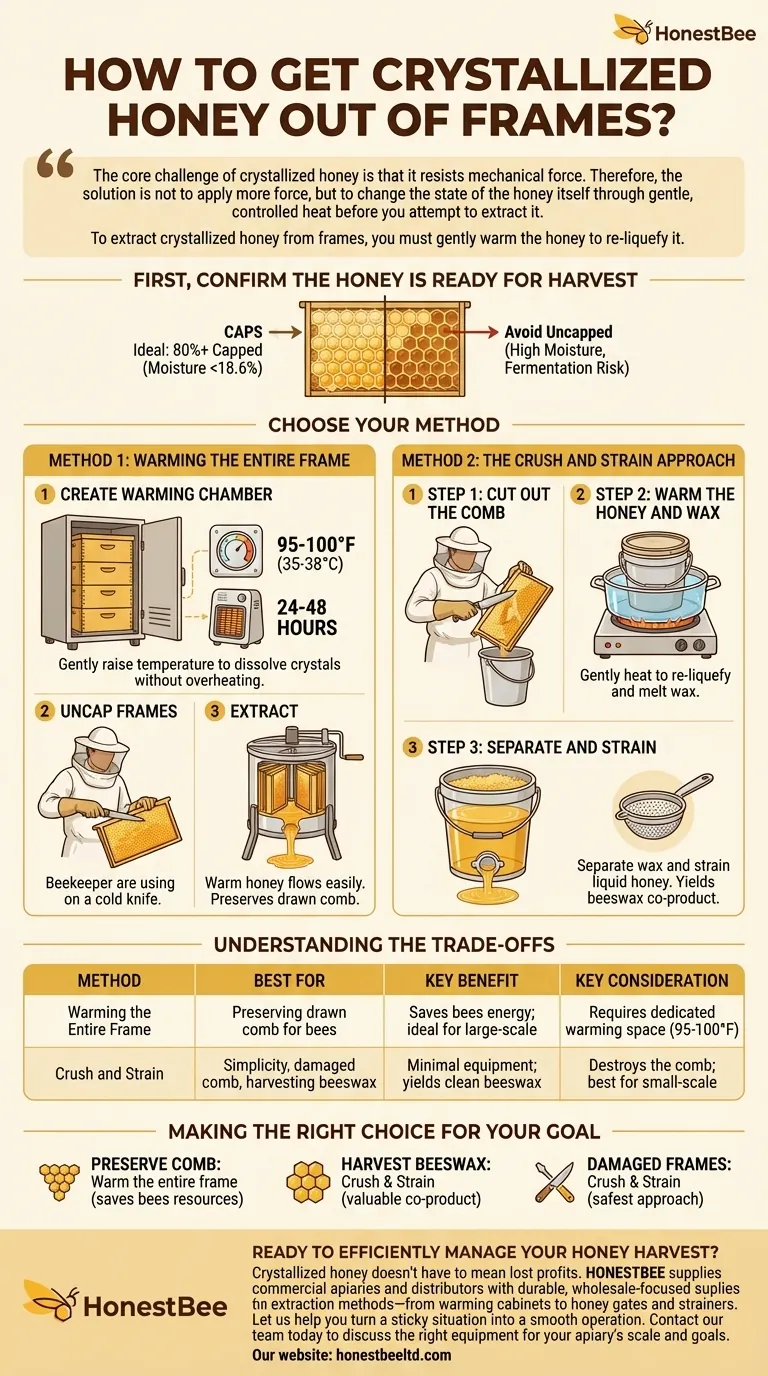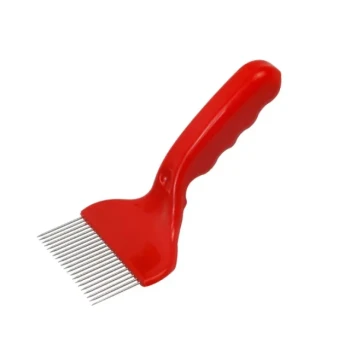To extract crystallized honey from frames, you must gently warm the honey to re-liquefy it before it can be processed. The two primary methods for this are either warming the entire frames in a controlled environment before uncapping and extracting, or cutting the comb out of the frames, warming it in a container, and then straining the wax from the liquid honey. A standard centrifugal extractor cannot handle solid, crystallized honey.
The core challenge of crystallized honey is that it resists mechanical force. Therefore, the solution is not to apply more force, but to change the state of the honey itself through gentle, controlled heat before you attempt to extract it.

First, Confirm the Honey is Ready for Harvest
Before addressing the crystallization, you must ensure the honey was ready for harvest in the first place. Processing honey with high moisture content will lead to fermentation and spoilage.
What is "Capped" Honey?
Capped honey is sealed in the honeycomb cells by the bees with a yellow-white waxy coating. You should see a majority of the frame, ideally 80% or more, covered in this protective wax layer.
Why Capping Matters
This wax capping is a definitive sign from the bees that the honey has been dehydrated to the proper moisture content (below 18.6%). This makes it stable for long-term storage. Attempting to process uncapped, crystallized honey can introduce moisture problems later on.
Method 1: Warming the Entire Frame
This approach is ideal if you wish to preserve the drawn-out comb for your bees to reuse, which saves them a tremendous amount of energy.
The Goal of Gentle Warming
Your objective is to raise the honey's temperature enough to dissolve the glucose crystals without overheating it. Overheating can destroy beneficial enzymes and negatively affect the honey's flavor.
How to Create a Warming Chamber
Place the honey supers or individual frames in a small, enclosed space like a closet or a dedicated warming cabinet. Use a small, thermostatically controlled space heater to slowly raise the ambient temperature to around 95-100°F (35-38°C). This may take 24-48 hours.
The Extraction Process
Once the honey is fully liquid within the comb, you can proceed with extraction as normal. Uncap the frames using a cold knife or other tool and place them in your centrifugal extractor. The warm honey will flow much more easily than even cool, liquid honey.
Method 2: The Crush and Strain Approach
This method is often simpler for a small-scale beekeeper and is the best choice for foundationless frames or frames with damaged comb. It also allows you to harvest the beeswax.
Step 1: Cut Out the Comb
Place the frame over a food-grade bucket. Use a hive tool or knife to carefully cut the entire comb away from the frame, letting it fall into the bucket.
Step 2: Warm the Honey and Wax
Place the sealed bucket in a larger water bath or warming tank. Gently heat the contents until the honey has completely de-crystallized and the wax has melted. Again, maintain a low temperature to protect the quality of the honey.
Step 3: Separate and Strain
Once everything is liquid, you can separate the components. Many beekeepers use a bucket with a spigot at the bottom (a honey gate). After letting it sit, the wax will rise to the top, and you can drain the pure, liquid honey from the bottom. The remaining honey-wax mixture can be strained through a cheesecloth or a fine mesh filter.
Understanding the Trade-offs
Neither method is universally superior; the best choice depends on your goals and equipment.
Preserving the Comb
Warming the entire frame is the only method that preserves the drawn comb. This is a significant advantage, as it takes bees a massive amount of resources to build new wax. The crush and strain method destroys the comb completely.
Equipment and Scale
The crush and strain method requires minimal specialized equipment beyond buckets and strainers, making it accessible for hobbyists. Warming entire supers is more efficient for larger operations but requires a dedicated, temperature-controlled space.
Harvesting Beeswax
The crush and strain method is an excellent way to harvest clean, high-quality beeswax as a valuable co-product. When warming frames, you only harvest the thin layer of wax from the cappings.
Making the Right Choice for Your Goal
- If your primary focus is preserving your drawn comb for the bees: Choose the method of warming the entire frame in a controlled environment before extraction.
- If your primary focus is simplicity and harvesting a large amount of beeswax: The crush and strain method is more direct and yields a valuable wax co-product.
- If you are working with foundationless or damaged frames: The crush and strain method is the most practical and safest approach to avoid comb blowouts.
Ultimately, both methods successfully reclaim your honey, turning a potential frustration into a valuable and usable harvest.
Summary Table:
| Method | Best For | Key Benefit | Key Consideration |
|---|---|---|---|
| Warming the Entire Frame | Preserving drawn comb for bees | Saves bees energy; ideal for large-scale operations | Requires a dedicated warming space (95-100°F / 35-38°C) |
| Crush and Strain | Simplicity, damaged comb, harvesting beeswax | Minimal equipment needed; yields clean beeswax | Destroys the comb; best for small-scale or hobbyist beekeepers |
Ready to efficiently manage your honey harvest?
Crystallized honey doesn't have to mean lost profits. HONESTBEE supplies commercial apiaries and beekeeping equipment distributors with the durable, wholesale-focused supplies needed for both extraction methods—from warming cabinets and honey gates to strainers and uncapping tools.
Let us help you turn a sticky situation into a smooth operation. Contact our team today to discuss the right equipment for your apiary's scale and goals.
Visual Guide

Related Products
- HONESTBEE 72 Frame Industrial Electric Honey Extractor for Beekeeping
- 2 Frame Stainless Steel Manual Honey Spinner Extractor for Beekeeping
- HONESTBEE 3-Frame Manual Acrylic Honey Extractor
- electric honey extractor honey centrifuge 3 frame honey extractor stainless steel honey frame extractor
- 40 Frame Commercial Electric Honey Extractor for Beekeeping
People Also Ask
- What should a beekeeper do after extracting honey from supers? A Guide to Harvest Management
- What is the energy consumption like for automatic honey extractors? Maximize Your Harvest Efficiency
- Can a manual extractor be upgraded to an electric one? Save Labor & Boost Efficiency
- How do automatic honey extractors function? Achieve High-Efficiency Honey Harvesting
- Why do beekeepers have to lift a lot of weight at the end of a growing season? The Reward of a Heavy Harvest



















